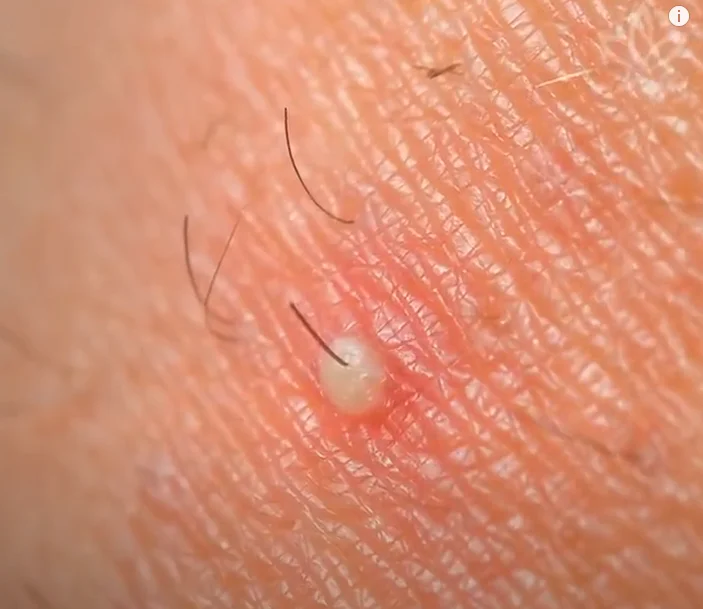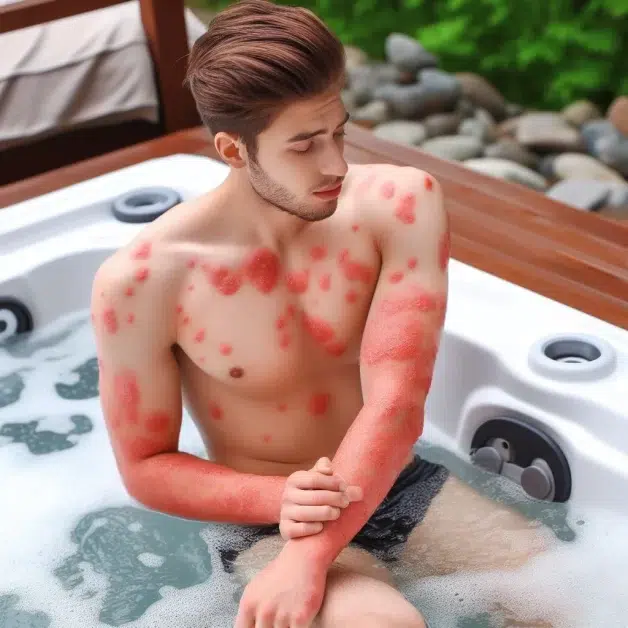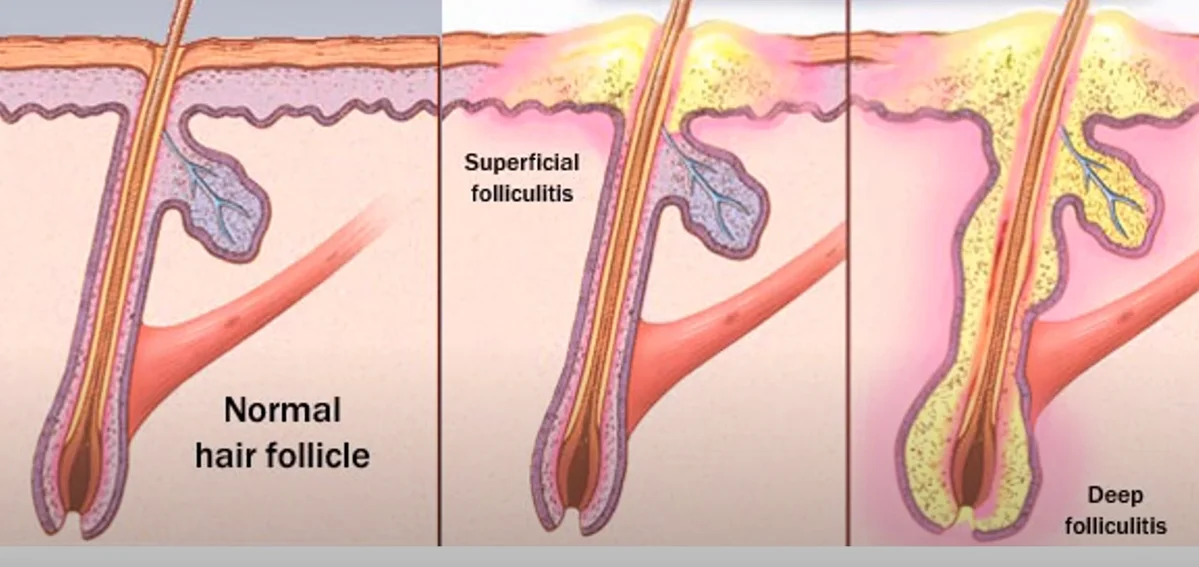Hot Tub Folliculitis: Causes, Prevention, and Treatment
Experiencing red bumps or an itchy rash after a soak in your hot tub? Hot tub folliculitis, a common skin issue caused by bacteria or poor maintenance, can certainly put a damper on your relaxation. We understand how such skin irritations can turn a relaxing experience into a bothersome one.
Whether you’re trying to understand why you’ve developed this condition or how to keep it from happening again, we’ve got you covered. From identifying the symptoms of folliculitis to explaining how it can be triggered by your hot tub, we’ll provide you with practical tips for treatment and prevention.
Get the lowdown on keeping your hot tub clean and safe, and learn how to avoid future skin troubles. Let’s tackle this issue and help you get back to enjoying your hot tub, without a hitch.
What is Hot Tub Folliculitis?
It, also known as pseudomonas folliculitis, is a skin infection of the hair follicles caused by a type of bacteria called Pseudomonas aeruginosa. This bacteria can be found in warm, moist environments, such as hot tubs, swimming pools, and whirlpools.

Symptoms:
Symptoms typically appear within 1 to 2 days after exposure to the bacteria. The most common symptom is an itchy, red rash that develops on the trunk, buttocks, and thighs. The rash may also appear on the face and neck. Other symptoms include:
- Small, pus-filled blisters.
- Red, tender nodules.
- Crusting and scaling of the skin.
- Fever, in some cases.
If you are more reading about hot tub yeast infection and its facts.
How to Prevent:
The best way to prevent hot tub folliculitis is to avoid exposure to contaminated water. However, there are a few other things you can do to reduce your risk, such as:
- Showering immediately before and after using a hot tub
- Avoiding sitting in a hot tub for longer than 30 minutes at a time
- Using a hot tub that has been adequately maintained and sanitized
- Avoiding hot tubs that are crowded or have cloudy water

Who is at Risk for Hot Tub Folliculitis?
Certain individuals are more prone to developing hot tub folliculitis:
- Children: Their skin is more sensitive and they may spend more time in hot tubs.
- People Assigned Female at Birth (AFAB): They might experience higher rates due to clothing and bathing practices.
- Individuals with Sensitive Skin: Those with pre-existing skin conditions may be more susceptible.
What Does Hot Tub Folliculitis Look Like?
The visual symptoms of hot tub folliculitis include:
- Red, Itchy Bumps: Typically found around hair follicles.
- Affected Areas: Can appear on the face, chest, arms, buttocks, genitals, and legs.
- Swimsuit Areas: Rash may be more pronounced where water is trapped under swimwear.
Does Hot Tub Folliculitis Have Other Names?
Hot tub folliculitis is also known by:
- Pseudomonas Folliculitis
- Hot Tub Rash
These names highlight the role of bacteria and their association with hot tub use.
How Common is Hot Tub Folliculitis?
The condition is quite common and can occur in various settings:
- Public Pools and Hot Tubs
- Water Parks
- Flotation Tanks
Research indicates that Pseudomonas aeruginosa is present in about two-thirds of these facilities, underscoring the widespread nature of the issue.
| Aspect | Details |
|---|---|
| Condition | Hot Tub Folliculitis |
| Cause | Pseudomonas aeruginosa |
| At-Risk Groups | Children, People Assigned Female at Birth (AFAB), Individuals with Sensitive Skin |
| Appearance | Red, itchy bumps around hair follicles |
| Alternate Names | Pseudomonas Folliculitis, Hot Tub Rash |
| Common Settings | Public pools, water parks, flotation tanks |
| Bacterial Presence | Approximately two-thirds of facilities |
Diagnosis and Tests
In most cases, a thorough examination and detailed history are sufficient to diagnose hot tub folliculitis accurately.
How Do Healthcare Providers Diagnose Hot Tub Folliculitis?
Diagnosing hot tub folliculitis typically involves:
- Medical History: Your healthcare provider will ask about your recent exposure to hot tubs or pools, which helps in identifying potential causes of the rash.
- Physical Examination: A visual inspection of the rash is crucial. The provider will look for characteristic symptoms such as itchy, red bumps around hair follicles.
- No Special Diagnostic Tests: Generally, no specific lab tests are required. However, if needed, a culture or Gram stain might be used to confirm the presence of Pseudomonas aeruginosa.
- Assessment of Symptoms: If you present with additional symptoms like fever or diarrhea, the provider will consider these in the overall diagnosis.

Treatment for Hot Tub Folliculitis
It can be resolved on its own within 1 to 2 weeks. However, there are a few things you can do to speed up the healing process and relieve symptoms, such as:
- Keep the area clean and dry. Gently wash the affected area with soap and water and pat it dry. Avoid using hot water, as this can irritate the skin.
- Apply over-the-counter hydrocortisone cream. This can help to reduce itching and inflammation.
- Take warm compresses. Soak a clean washcloth in warm water and apply it to the affected area for 15 to 20 minutes. This can help to soothe the skin and promote healing.
If the rash is severe or does not improve, your doctor may prescribe oral antibiotics.
Additional tips for treating:
- Avoid shaving or scratching the affected area, as this can spread the infection.
- Wear loose-fitting, comfortable clothing.
- Avoid using harsh soaps and detergents.
- Stay hydrated by drinking plenty of fluids.
See a doctor if you have any concerns about your symptoms or if the rash does not improve after 2 weeks.
Prevention
The best way to prevent this is to avoid exposure to contaminated water. Here are some tips:
- Shower immediately before and after using a hot tub.
- Avoid sitting in a hot tub for 30 minutes at a time.
- Use a hot tub that has been adequately maintained and sanitized.
- Avoid hot tubs that are crowded or have cloudy water.
You may be at increased risk if you have a weakened immune system. Be sure to take extra precautions to avoid exposure to the bacteria.
When to See a Doctor
You should see a doctor if you have any of the following symptoms:
- A rash that is severe or does not improve after 2 weeks
- An inflammation that is accompanied by a fever
- Painful or tender nodules
- Blisters that are open or draining pus
Hot tub folliculitis antibiotic
Most cases do not require antibiotic treatment, as the infection usually clears up within a week or two. However, some people may need antibiotics with severe or persistent symptoms, such as fever, pus-filled bumps, large or painful boils, or signs of a deeper skin infection.
In these cases, your healthcare provider may prescribe oral or topical antibiotics, such as ciprofloxacin, gentamicin, or mupirocin.
To prevent this, you should avoid using hot tubs or pools that are improperly maintained or disinfected. After using any water facility, you should shower with soap and water and thoroughly wash your bathing suit and towel.
If you have a hot tub at home, you should regularly check and adjust the pH and chlorine levels and drain and clean the tub every few months.
Disclaimer NOTE: The information in this blog post is intended for general awareness and should not be considered a substitute for professional medical advice. While most cases of hot tub folliculitis may resolve independently, individual experiences can vary.
It is crucial to consult with a qualified healthcare professional for personalized advice and guidance, especially if you are experiencing severe or persistent symptoms. The decision to use antibiotics or any medical intervention should be made in consultation with a healthcare provider.
🔍 Want more info? Head over to Hot Tub Patio 🛁 or check our Guides 📖 for extra reading!
Outlook / Prognosis
What to Expect if You Have Hot Tub Folliculitis
Hot tub folliculitis generally resolves on its own within one to two weeks. Here’s what to expect:
- Recovery Time: Most people see improvement in symptoms within a week. Mild cases usually clear up without medical intervention.
- Possible Residual Effects: In some instances, the rash may leave behind reddish-brown marks or skin pigmentation changes that could take a few months to fade completely.
- Recurrence: If you use a hot tub that hasn’t been properly cleaned, the infection might recur. Consistent maintenance of water quality can reduce the risk of future outbreaks.
Living With
Your healthcare provider can help manage more severe cases and ensure there are no underlying complications.
When to Consult a Healthcare Provider
While hot tub folliculitis often resolves without medical treatment, seek professional advice if you experience:
- Persistent Symptoms: If the rash doesn’t improve or worsens after two weeks.
- Severe Symptoms: Signs such as fever, persistent nausea, or significant discomfort.
- Additional Complications: If you notice any new symptoms, such as increased redness, swelling, or pus, which may indicate a secondary infection.
Common Queries:
- Oral Antibiotics for Folliculitis: Commonly prescribed oral antibiotics for this condition include ciprofloxacin or doxycycline.
- Shaving with Folliculitis: It’s advisable to avoid shaving affected areas until the condition has healed to prevent further irritation.
- Aggravating Factors for Folliculitis: Folliculitis can worsen due to friction from tight clothing, excessive sweating, and exposure to contaminated water.
- Healing Time for Folliculitis: The healing time varies, but improvement is typically seen within a week of starting appropriate treatment.
- Showering with Folliculitis: It is generally okay to shower with folliculitis, but avoid using harsh soaps and ensure the affected areas are gently cleaned and dried.
- Pain in Folliculitis: Folliculitis can be accompanied by discomfort and itching, but it is not always intensely painful.













2 Comments